Stem Cell Therapy for diabetes is being heavily investigated around the world. But, how does it work and can you get treatment for both Type 1 & Type 2 right now? We break down all the answers below.
If you’re considering Stem Cell Therapy, our team can guide you in deciding if it’s the right fit, help you choose the best clinic & region, and even assist you in securing some great discounts! Fill in our form here to set up a conversation.
How Stem Cell Therapy Works for Diabetes
Stem cell therapy works by replacing lost insulin producing cells in Type 1 or making the body more responsive to insulin in Type 2.
In Type 1 diabetes, stem cell therapy aims to replace the insulin-producing cells that the immune system destroyed. For Type 2, the focus is on reducing inflammation and making the body more responsive to insulin. Here’s how each approach works:
Stem cell Treatments for Type 1 Diabetes:
In Type 1 diabetes, the immune system destroys insulin-producing cells. Scientists are working on ways to replace these lost cells using a multi-step process, essentially rebuilding what the immune system destroyed.
Can Stem Cells Cure Type 1 Diabetes?
Stem cells haven’t been proven in trials to cure Type 1 diabetes yet, but trials are showing they can help the body produce insulin again and reduce the need for injections. Right now, clinics can’t offer you these treatments.
An article published in Springer ( check it out here) discusses islet cell transplantation as a potential long-term solution for Type 1 diabetes. However, donor islets are limited, which is why scientists are pushing for stem cell-derived beta cells as a more scalable option. Research is ongoing, but early data suggests that stem cell therapy could be a game-changer for Type 1 diabetes in the future.
Diabetes can be frustrating and overwhelming to treat. We’re not here to hype miracle cures. Our goal is to help you decide for yourself if it’s worth exploring, risks involved & treatment prices around the world.
Get Free GuidanceNo pressure. No spam. Just honest advice to help choose the right clinic.
Stem Cell Treatments for Type 2 Diabetes
Type 2 diabetes develops when the body stops responding properly to insulin (insulin resistance) and chronic inflammation damages beta cells in the pancreas. Unlike Type 1, the goal here isn’t to replace beta cells. It’s to reduce inflammation, restore insulin sensitivity, and support existing cells.
MSC Stem Cell Infusion
Mesenchymal Stem Cells (MSCs) are collected from bone marrow, fat tissue, or umbilical cord blood. These stem cells are known for their anti-inflammatory and regenerative properties.
IV Drip (No Surgery Required!)
MSCs are not injected into the pancreas. Instead, they’re delivered through an IV, allowing them to circulate naturally in the bloodstream. Once inside the body, MSCs home in on areas of inflammation, particularly in the pancreas.
Repairing the Body’s Insulin Response
MSCs reduce inflammation, which is one of the main causes of insulin resistance. They also help protect and support existing beta cells, allowing the body to naturally improve insulin production.
Can Stem Cell Therapy Treat Type 2 Diabetes?
Similar to Type 1 Diabetes, Stem Cell Therapy hasn’t been proven to cure diabetes, but research shows it may help reduce insulin resistance and protect beta cells from further damage.
Stem cell therapy for Type 2 diabetes isn’t about replacing beta cells. It’s about healing the ones you already have. By reducing inflammation and improving insulin sensitivity, MSCs offer a potential long-term solution beyond just managing symptoms.
How Much Does Stem Cell Therapy for Diabetes Cost?
Stem Cell therapy for diabetes costs between $6,500 to $15,000. There’s a few countries that shouldn’t be offering diabetes treatment that charge a fair bit higher, definitely be careful. We’ve gathered our pricing data in a few different ways & we’re always updating it! Here’s more of a breakdown by country:
- India: $6,500+. (View India Country & Cost Guide)
- Japan: $15,000 (View Japan Country & Cost Guide)
- Colombia: $10,000 – $12,000 (View Colombia Country & Cost Guide
Best Stem Cell Therapy clinics for Diabetes
We don’t let any clinic just sign up or pay to be listed.
We speak to every clinic directly and review their medical team, the treatments they offer, how their stem cells are sourced and how they follow up with patients after treatment.
We also review licensing documents to confirm they meet the legal and medical standards of the country they operate in. For example, whether cells are processed in a GMP-certified facility or if they provide documentation on stem cell quality.
Clinics must also agree to let us collect and publish independent patient reviews. Both positive and negative.

Why Use Alt Treatment?
We don’t just list clinics, we help you choose the right one, get the best pricing and support you through the entire journey. For free.
Compare with Confidence: Get clinic matches based on your condition, location, and budget.
Ask the Right Questions: Know what to ask before committing
Save on Treatment: Unlock exclusive discounts on vetted clinics and follow-up care.
We’re With You After Treatment: We check in post-treatment and help resolve any issues.
Travel & Visa Help: Need to travel for care? We can help with logistics, documents, and local tips.
Found a Clinic Elsewhere? We’ll check their licensing and track record for you, free of charge.
No Strings Attached: Even if you choose a clinic we don’t partner with, we’re still here to help you make the best decision.
Top Stem Cell Therapy Clinics for Diabetes
We’ve vetted Stem Cell Therapy clinics globally who treat Diabetes. Information on their processes, standards they follow & prices are on their profiles.
Compare Clinics GloballyWhat does the Research Say about Stem Cells treating Diabetes?
Stem cell therapy is showing real promise for treating diabetes, with some patients already reducing or eliminating their insulin use. However, most treatments are still in early stages, and larger trials are needed before they become widely available
Key Findings from Clinical Stem Cell Trials treating Diabetes:
- Most studies are still in early phases (83.2% are in Phase I/II).
- Mesenchymal Stem Cells (MSCs) are the most commonly tested for Type 2 diabetes, aiming to improve insulin sensitivity.
- For Type 1 diabetes, trials are focusing on beta cell replacement, with some patients already seeing reduced insulin dependency.
Breakthrough Stem Cell Diabetes Trials to Watch:
- Vertex VX-880 (U.S.) – Some Type 1 diabetes patients have cut back or stopped insulin use after receiving lab-grown beta cells. (Their press release is here)
- Hypoimmune Islet Cell Transplant (Norway) – A groundbreaking trial testing gene-edited cells that avoid immune rejection, eliminating the need for immunosuppressants. (Sana Biotechnology announced this in January 2025 here)
- AlloStem (U.S.) – An allogeneic (donor-derived) stem cell therapy that helped 80% of Type 2 diabetes patients reduce insulin use. (Creative Medical Technology just released results in February 2024 here)
The Bottom Line:
Stem cell therapy is making progress, with some patients already seeing life-changing benefits. However, these treatments are still experimental.
To look at the studies in more detail, check out this article here.
Stem Cell Therapy for Diabetes: Latest 2025 Updates
ADSCC
Abu Dhabi Stem Cells Centre Diabetes Breakthrough
In January 2025, the Abu Dhabi Stem Cells Center (ADSCC) announced a 20-year-old patient with Type 1 diabetes showed significant improvement after receiving umbilical cord-derived mesenchymal stem cell (UC-MSC) therapy. Within just a month, blood sugar levels improved, and key diabetes antibodies decreased. No side effects we’re seen and insulin use dropped. ADSCC is now preparing to expand this therapy for Type 2 diabetes patients.
Brown’s Lab
Dr Brown received a $700,000 grant to create Hypoimmune Islet Cells
Researchers at Brown’s lab, including Assistant Professor Matthew E. Brown, have received a $700,000 grant to explore a promising new approach for treating type 1 diabetes with Stem Cells according to a press release printed by Wisconsin University. Their goal is to use stem cells and reprogram them into Islet-like cells. These are the insulin-producing cells that people with type 1 diabetes lose. Then, they’ll use gene editing techniques to make them Hypo Immune, meaning the immune system won’t recognize and attack them like it normally would.
Kyoto University Hospital
Kyoto Hospital In Japan performs iPSC Stem Cell Therapy on Diabetes Patient
According to an article published by Japan Wire in April 2025, Doctors at Kyoto University Hospital in Japan have successfully completed a first test using stem cells to help a patient with type 1 diabetes make their own insulin again. In February 2025, they transplanted IPSc Cells which have been reprogrammed as Islet Cells, under the skin near the stomach. These new cells are designed to replace the insulin-making cells destroyed by the disease, meaning the patient may no longer need daily insulin injections.
Benefits of Stem Cell Therapy for Diabetes
- Potential to Stop Insulin Injections: For Type 1 diabetes patients, this could mean no more daily insulin shots.
- Better Insulin Sensitivity: For Type 2 diabetes, MSCs might help your body respond better to insulin.
- Natural Healing: Stem cells work by restoring the body’s own ability to regulate blood sugar.
What Are the Side Effects of Getting Stem Cell Therapy for Diabetes?
Looking into Stem Cell clinics for Diabetes?
Browse verified stem cell clinics in Colombia, Japan and more that we’ve already personally vetted.
Browse Verified Stem Cell ClinicsThe side effects of stem cell therapy for diabetes are generally mild, with most patients experiencing temporary inflammation, fever, or flu-like symptoms. So far, nothing serious has shown up. Serious risks, like immune rejection or uncontrolled cell growth, are rare but still being studied. Here’s what you need to know:
Well-Tolerated in Most Cases
- Clinical trials using stem cell-derived beta cells for Type 1 diabetes (e.g., Vertex, Sana Biotechnology) and mesenchymal stem cells (MSCs) for Type 2 diabetes have reported no serious side effects in most patients.
- The most common mild side effects include temporary inflammation, fever, or flu-like symptoms after infusion.
Risk of Ineffectiveness (MSCs for Type 2 Diabetes)
- MSCs have strong anti-inflammatory properties, but their ability to fully reverse Type 2 diabetes is still being studied.
- The AlloStem (CELZ-201) trial showed that 80% of patients reduced their insulin use, but long-term success remains unclear.
- Some research suggests that MSCs may not survive long enough in the body to produce lasting effects, meaning multiple treatments may be required.
Potential Risks with iPSCs & Beta Cell Therapy
- Immune System Response: iPSC-derived beta cells may trigger immune rejection, requiring immunosuppressants.
- Uncontrolled Cell Growth: A major safety concern with iPSCs is the potential for tumor formation, though current trials are addressing this risk.
What is the new diabetes cure in 2025?
While there’s still no permanent cure for diabetes in 2025, emerging treatments like stem cell therapy are making real progress. Some patients in clinical trials have been able to reduce or even eliminate their need for insulin. And there are clinics in certain countries that offer stem cell treatments for Type 1 & type 2 Diabetes.
But how does it compare to other treatments like insulin therapy, pancreas transplants, or medications like Ozempic? Let’s break it down.”
| Treatment | How it Works | Effectiveness | Risks & Downsides | Availability |
| Stem Cell Therapy | Uses stem cells to regenerate insulin-producing beta cells | Still in clinical trials, but early results show promise for reducing or eliminating insulin dependency | Long-term safety and effectiveness unknown; expensive and not widely available yet | Limited to clinical trials or select clinics in certain countries |
| Insulin Therapy | Patients inject insulin to regulate blood sugar | Effective at managing blood sugar but does not cure diabetes | Requires lifelong use; risk of hypoglycemia (low blood sugar) | Widely available; standard treatment for Type 1 & advanced Type 2 diabetes |
| Pancreas Transplant | Replaces a diseased pancreas with a healthy donor organ | Can restore insulin production, potentially curing Type 1 diabetes | Requires lifelong immunosuppressants; high risk of complications | Only available to select patients, usually those with severe diabetes and kidney failure |
GLP-1 Receptor Agonists (Ozempic, Mounjaro, etc.) | Stimulates insulin production and reduces appetite | Helps with blood sugar control and weight loss in Type 2 diabetes | Can cause nausea, vomiting, and long-term effects are still being studied | Prescription-only, but increasingly available for Type 2 diabetes management |
Is Stem Cell Therapy worth it for Diabetes?
Stem cell therapy is making real progress for diabetes, but it’s not a PROVEN cure. YET.
For Type 1 diabetes, clinical trials using stem cell-derived beta cells are showing promise in restoring insulin production, with some patients reducing or even eliminating insulin use.
For Type 2 diabetes, mesenchymal stem cells (MSCs) have been explored as a way to reduce inflammation and improve insulin sensitivity, but recent results from trials like AlloStem suggest allogeneic stem cells may also help restore pancreatic function.
Safety wise? So far, clinical trials show that stem cell therapy for diabetes appears to be safe, with no major side effects reported in regulated studies. But since this is still a new field, we don’t have long-term data yet. For Type 1 diabetes, some treatments may require immune suppressing drugs, which come with their own risks.
So, if you’re thinking about getting Stem cells for your diabetes, yes there’s some really interesting results being found in trials. BUT, understand it’s not 100% going to work for you. It looks like it’s not dangerous, but don’t expect to get treatment and be fully cured. There’s still a chance you could pay a lot of money & see no results.
If you want to see what other conditions Stem Cell Therapy can treat, check out our article on What conditions Stem Cell Therapy can treat!
If you’re deciding which country is best for you, or want to talk about clinics we’ve already vetted, fill out our form below. Our team will guide you with clear, honest answers.
Alt Treatment is a free, independent platform that helps you understand stem cell therapy & decide if it’s right for you.
We break down complex information into clear, honest guidance. When you’re ready, we can connect you with verified clinics that meet your needs, in the right location, and often with exclusive discounts.
There’s no charge to use our platform. No hidden fees. No pressure. Our main aim is to genuinely help you figure out if treatment is right & the best places to consider.
If you want to talk, fill out our form here & our personal concierge team will reach out.
Japan, Colombia, South Korea & Mexico are amongst the countries you can get Stem Cell Diabetes treatments in. To view clinics globally that can treat diabetes, you can compare them all here.
Potentially! Especially with Mesenchymal Stem Cells (MSCs) from umbilical cord tissue, these often work well for arthritis. These MSCs are potent and reduce inflammation, which helps repair damaged cartilage. As a result, many clinics prefer them over other types. Plus, they are less likely to cause an immune response.
Most Common countries people get treatment from are Colombia, Mexico, Panama, Thailand, India & Japan. People do get treatment from the US too, there’s differences in each region, check out our article on Differences Between Stem Cell Therapy in Mexico, and Other Countries
No. Most treatments involve using reprogrammed Stem Cells (iPSC cells) & these are only available in clinical trials.
Yes, the most common side effects of getting Stem Cell therapy are fever and local pain/swelling at the injection site. We go into more detail on our article on Stem Cell Therapy Side Effects.
Fill in your details below
For a discounted offer for Stem Cell Therapy!







